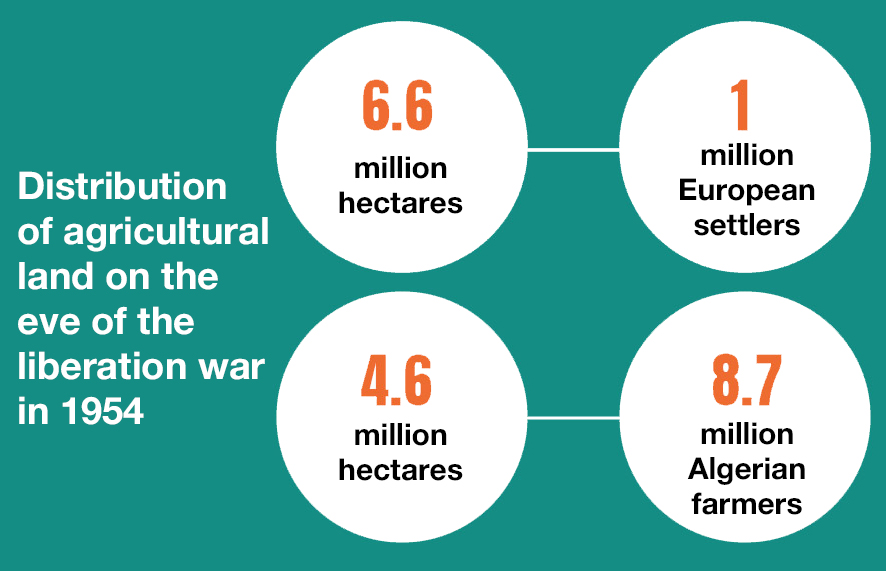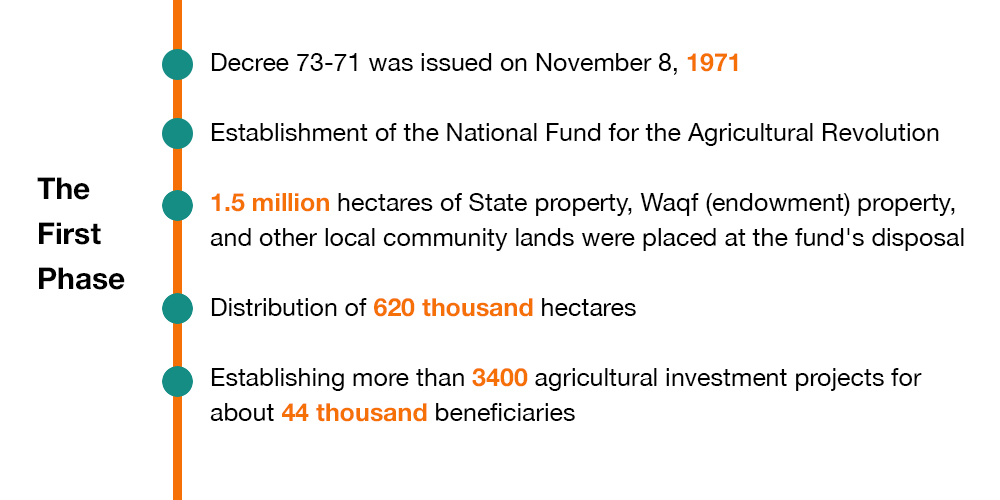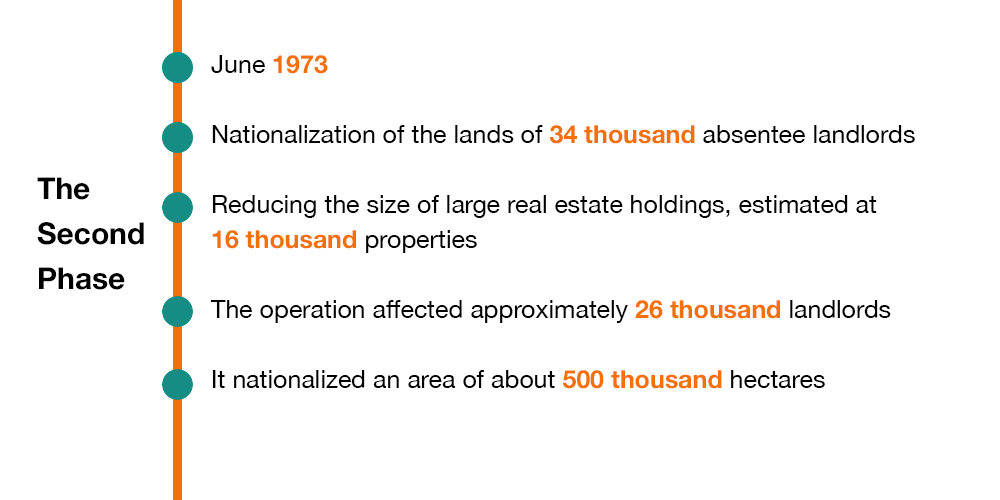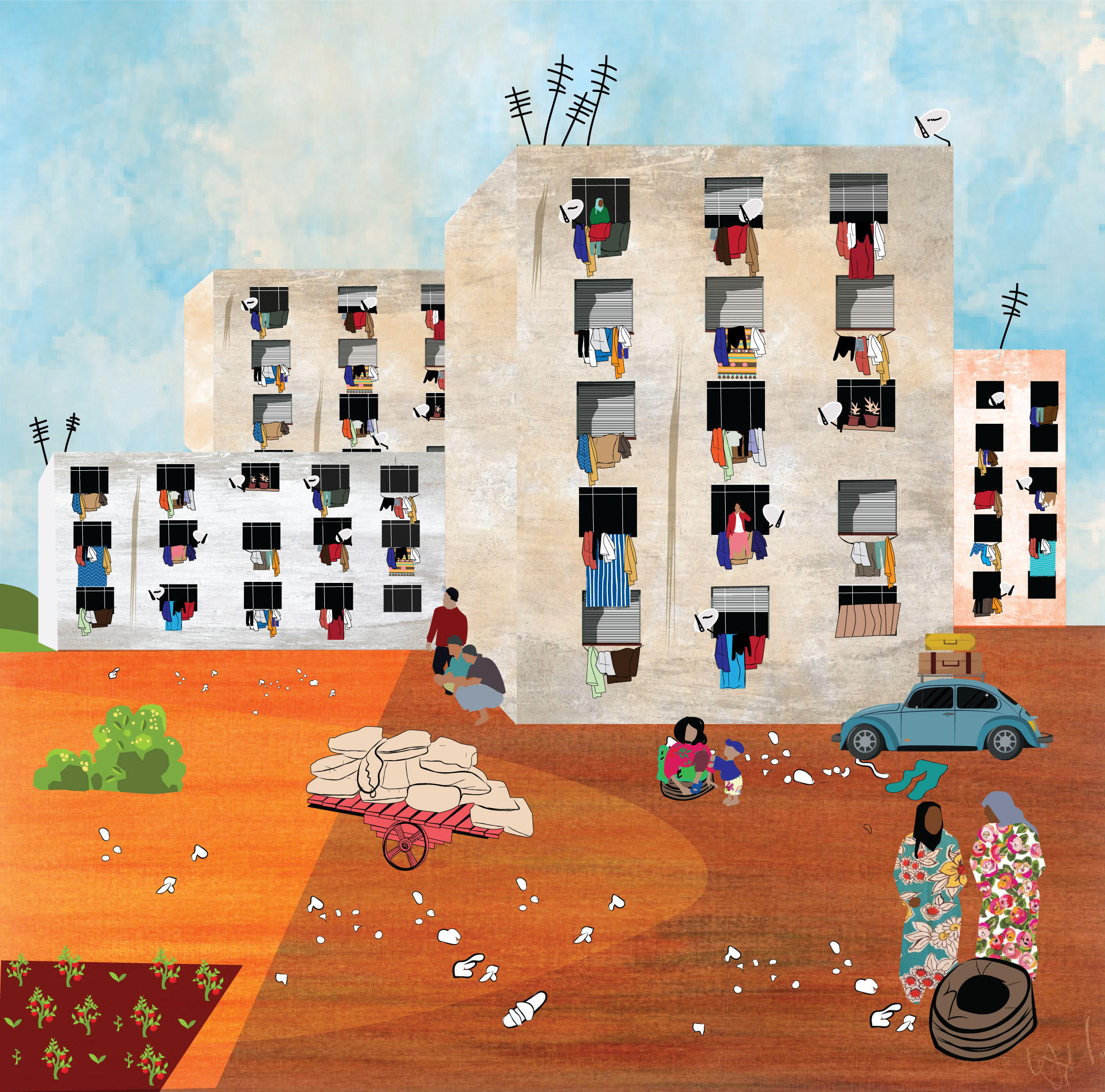
This publication has benefited from the support of the Rosa Luxemburg Foundation. This text may be reproduced in part or in full, provided the source is acknowledged.
The land issue in Algeria is extremely sensitive, for it was fundamentally related to the violent settler colonialism that worked on seizing the lands of people by force through exploiting laws and utilizing economic tools and pressures. This historical dimension should be taken into consideration if one is to fully comprehend the evolution of the agricultural policies adopted after independence. Land issues were also associated with the comprehensive policies of the state that ranged between a socialist tendency of a distinctive nature -to distinguish it from what was occurring in the socialist countries in the former Eastern Europe- and a hesitant liberalism that was never overtly adopted.
Systematic colonial destruction and plundering
Before the French colonialization, which started in 1830, the prevailing land property system was of a collective nature. There were the Arsh (tribal) lands, which were originally under the ruler's jurisdiction, but the Aroush (Berber tribes) benefited from them freely, as the farmer could cultivate these lands, but was unable to transfer their ownership or sell them.
There were also the Mulk properties, which are basically classical private properties, but which are often subject to the principle of communalism. The collective owners used to individually benefit from their lands but could not sell them. These properties were the basis of the strong social cohesion prevailing in the rural Algerian areas. There were also the Waqf (endowment) lands and the Beylik lands that could not be sold and whose ownership could not be transferred, but which could only be exploited collectively.
The principle of collective exploitation created balance and equity in the standard of living that preserved the general social cohesion. This was the most important thing that colonialism targeted by destroying the land ownership system in Algeria. The aim was to disintegrate the traditional cohesive society and seize the lands to satisfy the needs of the colonial settlements and usurp the people's lands in order to unleash a workforce that was to be deployed in the emerging colonial economy.
This colonial systematic process resulted in an almost complete destruction of the traditional society fabric in Algeria. The enacted laws worked on undermining the community ownership system that forbade selling lands. It also targeted the tribal and endowed lands whose collective use secured a balanced means of living among the inhabitants, albeit in different proportions.
All this took place with appalling violence as the colonial army evicted the tribes from their lands and declared them “bare fallow,” with the purpose of distributing them to the arriving settlers. The lands of Arsh (tribes) and the Beylik were declared lands of public interest to evict the farmers who were sometimes compensated with barren lands. The Warnier Law of 1873 was the legal tool that enabled the colonialist power, under the pretext of “documenting Algerian individual ownership,” to destroy the community ownership system. Farmers were then given loans with high interest rates, which inevitably lead to their rapid inability to pay off their debts and, consequently, forcing them to sell their lands.

It was through all these means of violence, including laws and economic tools, that the Algerian countryside was drastically altered. On the eve of the revolution that was launched on November 1, 1954, the distribution of the agricultural lands was marked by a terrible inequality. The best lands for cultivation were placed in the hands of the European settlers, while most Algerian farmers turned to seasonal agricultural workers. According to the statistics carried out at that time, 6.6 million hectares of the finest lands were owned by one million European settlers, while 8.7 million Algerians held 4.6 million hectares. It is worth mentioning that the value of the lands of the Europeans were three times more than those of the Algerians.
The collective exploitation of land provided balance and equality that maintained general social harmony. This was what the colonial power specifically targeted by destroying the agricultural land ownership system in Algeria.
On the eve of the 1954 revolution, the distribution of the agricultural lands was marked by a terrible inequality. The best lands for cultivation were placed in the hands of the European settlers, while most Algerian farmers turned to seasonal agricultural workers.
The conditions of the Algerian countryside on the eve of the revolution were utterly catastrophic, mainly because of the economic and social status of the farmers who were transformed into wageworkers after being forced to relinquish their lands. Only a few Algerian landowners of large estates survived as they allied with the colonizer, which allowed them to preserve their lands and properties.
Thus, it was not surprising that the rural areas were the ones that bore the brunt of the Algerian revolution, branding it with that strong and determined popular character. During the war of liberation, the countryside was exposed to harsh treatment as the colonial forces evicted the residents from their lands and gathered them in camps to separate the rebels from the rest of the inhabitants. These actions had a profound impact on the remaining Algerian rural areas, which also affected the policies implemented post-independence.
Spontaneous post-colonial self-management
While the national movement’s discourse mentioned the necessity of agricultural reform, there were no articulate thoughts on the subject. Thus, upon independence, an urgent matter had to be resolved, which had to do with the question of how to deal with an agricultural sector that has witnessed a major disruption due to the mass immigration of the French settlers. The biggest farms were abandoned and left in the hands of the agricultural workers who quickly worked on securing that year’s season. They were organized in the form of working committees to maintain the continuity of the work and save the season. Spontaneously and out of urgent necessity, the first signs of the self-management system emerged. This was accomplished without direct supervision or direction from the newly-found state or the Liberation Front. Also, the Tripoli Charter, endorsed by the convention held in the Libyan capital at the end of May 1962, did not refer to the self-management system created spontaneously by the workers. This system practically constituted a means of protection against the possession of new feudal owners of the lands that were deserted by the biggest French settlers.
No legal texts that organize the self-management of the agricultural sector appeared until the publication of the March 18 decrees, which opted to place the vacant properties under administrative custody. There was the 88-63 decree related to the vacant properties in the industrial, commercial, financial, and mines sectors, as well as the agricultural and forest investments. As for the 89-63 decree, it dealt with organizing farming and agricultural reform. It also established the National Office for Agrarian Reform as a governmental agency tasked with “the Agricultural Reform Program and running the farms abandoned by their owners.”
These decrees covered more than 22 thousand farms with a total area estimated at around 2.2 million hectares. The self-management is based on "The General Workers Assembly," which appointed a management committee that chose its own president. The income distribution was also set in such a way that a part of it was provided to the national group while the rest remains as an investment in the farmer's self-management agricultural projects. In October 1963, a conference for the farmers was held in which farmers from all the regions of Algeria participated. This phase was distinguished by a special kind of zeal and romanticism that lasted until the year 1964.
Furthermore, the colonial era influenced a major shift in mentalities. Even if the regulation of the self-management system has enabled the work to continue, it did not resolve the issue of ownership. That system began to crumble and was gradually replaced by the direct management of the state’s bureaucracy as well as the frameworks of the party. The independence of the management committees drew back in favor of the Ministry of Agriculture’s frameworks, and the farmers working in the self-management farms turned into employees supervised by framing technicians representing the Ministry. Moreover, since the self-management system was restricted only to the lands of the settlers, most of the poor farmers living in the lands of low returns were left out of this agricultural system. Accordingly, the remaining sector, represented by the small and poor holders, was almost neglected, which forced the families to leave their lands and migrate to the cities. This trend continued even after independence, remaining as it was during the 132 years of colonialism. Changes in the social domain, such as family grants and social security, were not available, except for the "socialist" sector and the paid workers in the agricultural sector. Thus, changes in this traditional sector did not occur until after the year 1971 with the beginning of the Agricultural Revolution.
“The Agricultural Revolution”


Houari Boumediene's regime, which took over after the deposal of Ahmed bin Bella on June 19, 1971, focused on building the state and the army. These political concerns were primarily related to bolstering the regime, which did not consider the agricultural sector a priority. However, everything changed with the issuing of decree 73-71 on November 8, 1971 that instituted the “Agricultural Revolution”, which not only nationalized the lands but also created the conditions for their reclamation and valuation for the benefit of the rural masses, adopting the slogan “the land is for those who serve it.”
The government initiated a National Fund for the Agricultural Revolution, and placed under its disposal state and Waqf lands, in addition to the lands of the other local groups, all of which comprised approximately 1.5 million hectares. In the first year of its implementation, around 620 thousand hectares were distributed, leading to the establishment of more than 3400 agricultural investment projects for approximately 44 thousand beneficiaries. The forms of these investments varied, from farmers' cooperatives for production under the Agricultural Revolution to farmer's cooperatives of collective exploitation, among other forms.
A more controversial second phase was launched in June 1973, aiming at nationalizing the lands of their absent owners estimated at more than 34 thousand. It also targeted limiting the size of the large estates estimated at around 16 thousand properties. These nationalized lands were supposed to be added to the national fund of the Agricultural Revolution. This operation was supported and backed by the Algerian left under the umbrella of The Socialist Vanguard Party, the descendent of the Algerian Communist Party, who worked on recruiting students in voluntary campaigns in the rural areas to "raise the farmers’ awareness” and help them confront what they called the “Algerian feudalist maneuvers.”
The Agricultural Revolution of 1971 can be summarized as the redistribution of 1.1 million hectares of land and the building of 200 socialist agricultural villages of the One-Thousand Villages project. Even if the Agricultural Revolution still stirred up feelings of nostalgia among certain leftist groups due to its "goodhearted" intentions in modernizing the rural sector through a progressive perspective, the fact remained that bureaucratic frameworks stood as a large barrier before it.
But the operation faced strong resistance from the conservatives and the Algerian bourgeoisie that were present in the administration of the state and limited its impact. This operation affected around 26 thousand owners by nationalizing an area of approximately 500 thousand hectares.
As for the third phase that dealt with the pastoral sector, due to the fierce resistance of the major breeders, no success was achieved. As a result, the outcome of the Agricultural revolution of the year 1971 was the redistribution of 1.1 million hectares of land and the construction of 200 socialist agricultural villages of the one thousand initially planned.
Even if the Agricultural Revolution still stirred up feelings of nostalgia among certain leftist groups due to its "goodhearted" intentions in modernizing the rural sector through a progressive perspective, the fact remained that bureaucratic frameworks stood as a large barrier before it. In addition, the transformation of the farmers into semi-employees drastically affected production, tainting the image of the Agricultural Revolution. This setback was fully exploited by the opponents of progressive inclinations who strived to end the revolution within a general authoritarian context calling for an open door policy.
The Agricultural Reform of 1987 or reserved openness
After the death of Houari Boumediene in December 1978, Algeria entered a new phase represented by the movement towards a liberal "open door policy" that started out quite reserved. A reforming attempt occurred in 1981 that did not have a significant impact. This was before the so-called reorganization of the agricultural sector in the year 1987 that aimed to redefine and strengthen the rights and obligations of the producers. The new law framework redefined the size of investments by forming collective farmers' groups of 4 to 11 members or individual farmer groups when the conditions for establishing the collective groups were not available. The hasted manner of the execution of the operation resulted in the distribution of 10 percent of the lands outside the scope of the law. This pushed the owners whose lands were nationalized to protest and file complaints in courts.
Even though agricultural policies have gradually evolved towards "dropping" the ideological view on land issues in favor of returns, the desired outcomes did not materialize. The 1987 law granted the right of using the land and the right to possess the deeds of the farmers' investment projects. This was essentially supposed to be a boost to the sector, but in reality, it led to a lot of problems, such as the instability of the real estate base, the use of lands and their facilities for other non-agricultural purposes, as well as a decrease in investments and the evolving of the pre-paid harvest phenomena.
To set things straight, law number 25-90 in relation with real-estate directives was passed on November 18, 1990, providing a general framework for agricultural policies. However, this law was too general, merely classifying the types of lands (agricultural or intended for agriculture, forest or intended for forestation, lands covered with Pampa grass or intended for Pampa farming, desert lands, urban lands or lands suitable for construction, and protected areas reservations). The law provided only general directions referring the modality of implementation to special (to be enacted) laws. Nevertheless, no regulative laws were issued to determine these modalities. All of that created a general deterioration, considering that out of 47 million hectares of potential agricultural lands, only 8.5 million hectares could be extensively exploited.
The strong demand for dwellings drove the authorities to pass many laws that facilitated the declassifying of agricultural areas. In this regard, regulative laws were issued to allow for declassifying agricultural lands in a way that was, according to experts, astonishing and worrisome, especially that it was happening at a time when the new trend in many countries of the world was to buy agricultural lands in various other countries to ensure their food security. These experts could not comprehend how Algeria could squander such a rare, nonrenewable resource for construction purposes, in almost the entire country. This phenomenon is still unfolding, even though a new article has been added to the constitution, stipulating that “The State shall guarantee the rational use of natural resources and their preservation for the benefit of future generations. The State shall protect agricultural lands, just as it shall conserve public water domain. The law defines the modalities of implementing this provision.” (Article 19 of the Algerian Constitution)
Transition to a system of concession
In order to remedy the prevailing recession in the agricultural sector, a national plan was implemented, at the beginning of the year 2000, where significant money amounts were allocated to support the farmers to renovate their investments. While some improvements were noticed, the results seemed modest considering the efforts exerted. Some experts point out that the execution of the plan, was not preceded by adequate preparation, suffered from bureaucratic management, and lacked following up.
The promulgation of the agricultural directive law in 2008 allowed different settlements for various aspects of the agricultural lands, which granted a legal guarantee for the owners of the land investment projects. The owners who benefitted from the right of concession reached, in May 2018, around 219 thousand farmers with an area of 2.4 million hectares of the government’s properties. This policy towards more openness became clearer in the August 14, 2010 law, which defined the conditions and procedures of exploiting agricultural lands of the state’s private properties.
This law affirmed the principle of concession for Algerians, based on a list of conditions, for 40 renewable years. It included both collective and individual agricultural investments, whereby the owners of concessions pay an annual due determined by the financial law. Furthermore, a concession for land reclamation in the steppe and desert lands was deemed permissible, and hence, there was a rush to obtain such rights. Nevertheless, the press mentioned many situations where aid and loans were granted to beneficiaries who did not do anything to cultivate the lands, which prompted the government to take a decision to retrieve all lands that were not cultivated.
In April 2018, an official in the real-estate regulation division of the Ministry of Agriculture reasserted the need to exploit Arsh (tribal) lands. He estimated the area of those lands to be somewhere between 2 and 2.5 million hectares, which he believes should be “exploited to raise their value and support the farmers with administrative contracts,” indicating that there are more than 3 million hectares of unexploited agricultural land, which is around 67 percent of the arable lands.
At the beginning of the new millennium, a national plan to develop the agricultural sector was implemented, whereby a significant sum of money was allocated to support farmers’ land investments. While some improvements were noticed, the results seemed modest considering the efforts exerted. Some experts point out that the execution of the plan lacked preparation, suffered from bureaucratic management, and lacked necessary follow-ups.
In the recent years, there has been a big debate regarding the exemplary farms of the state (formed in the year 1990 as per the real estate directive law). There are around 190 of those farms, whose areas vary between 50 and 70 hectares, and they specialize in producing plant and animal products necessary for the implementation of the national production plans. The debate revolved around the semi-secret privatization of some of these exemplary farms, by the government of Abdelmalek Sellal in 2017, under the pretext that they were abandoned and unexploited. However, his successor canceled these decisions by freezing the ceded lands of 25 exemplary agricultural farms.
However, putting aside all the ideological wagers present since the country’s independence, which are a reflection of the conflicts over the direction of state-owned real estate, the biggest issue in Algeria is the feebleness of arable areas considering the demographic development as well as securing an acceptable level of food security.
The content of this publication is the sole responsibility of Assafir Al-Arabi and Rosa Luxemburg Foundation cannot accept any liability for it.
Translated from Arabic by Ghassan Rimlawi
Published in Assafir Al-Arabi on 06/04/2019




